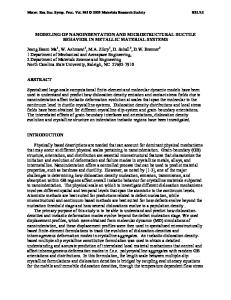Glass Material Modeling and its Molding Behavior
- PDF / 728,538 Bytes
- 11 Pages / 612 x 792 pts (letter) Page_size
- 64 Downloads / 354 Views
Glass Material Modeling and its Molding Behavior Gang Liu 1, Anh-Tuan Vu1, Olaf Dambon 1, Fritz Klocke 1 1 Fraunhofer Institute for Production Technology IPT, Aachen, Germany
ABSTRACT Precision molding is a replicative production method for the mass production of complex glass optics in high precision. In contrast to the traditional material removal process, such as grinding and polishing, the surface as well as the entire shape of the optical component is created by deforming glass at elevated temperatures using precise molding tools with optical surfaces. The molded glass components present high shape accuracy and surface finish after the molding process, therefore no further processing is required. During the molding process, the glass is heated in the molding tool up to above the transition temperature Tg, then pressed into desired shape and cooled down to approximately 200 °C. The precision glass molding is therefore a complex thermo-mechanical process, in which the glass lens undergoes uneven cooling speed and stress distribution. These lead to several drawbacks on the molded glass optics, such as form deviation, index change and fracture. In this study, FEM simulation was employed in order to achieve preliminary understanding of the molding process. The FEM model included viscoelasticity behavior of glass material (stress-relaxation, structure-relaxation and thermosrheological simplicity), as well as thermodynamics model of the molding machine. In the form of a case study of a real molding example, the form deviation, index change and fracture of the molded glass optic were predicted in advance of the molding experiment by means of the numerical calculation of thermal shrinkage, volume change and stress distribution respectively. The good agreement between simulation results and molding experiment results proves the accuracy of the developed FEM model.
INTRODUCTION Precision glass molding (PGM) is a replicative technology using ultra-precision molds with protective coatings to deform glass blanks. For this, a volume-proportioned glass blank that has already desired optical surface quality, called glass gob, is firstly loaded into the molding tools, typical material of tungsten carbide WC. Then, the glass blank and the molding tool are heated up simultaneously to a specific molding temperature, which is above Tg, followed by a well-defined pressing step. Subsequently, a controlled gradual cooling step with holding force and steep cooling step without force are carried out where the glass gradually returns into solidlike state until finally the ready-to-use glass optic is taken out of the mold. Subsequent machining operations, especially of the functional optical surface, are therefore no longer necessary. The schematic procedure and process cycle of PGM process are presented in Figure 1. Although PGM process has been studied and applied for years, its economic viability is strongly limited by several factors, such as form deviation, refractive index variation and glass fracture. These phenomena are caused by
Data Loading...











